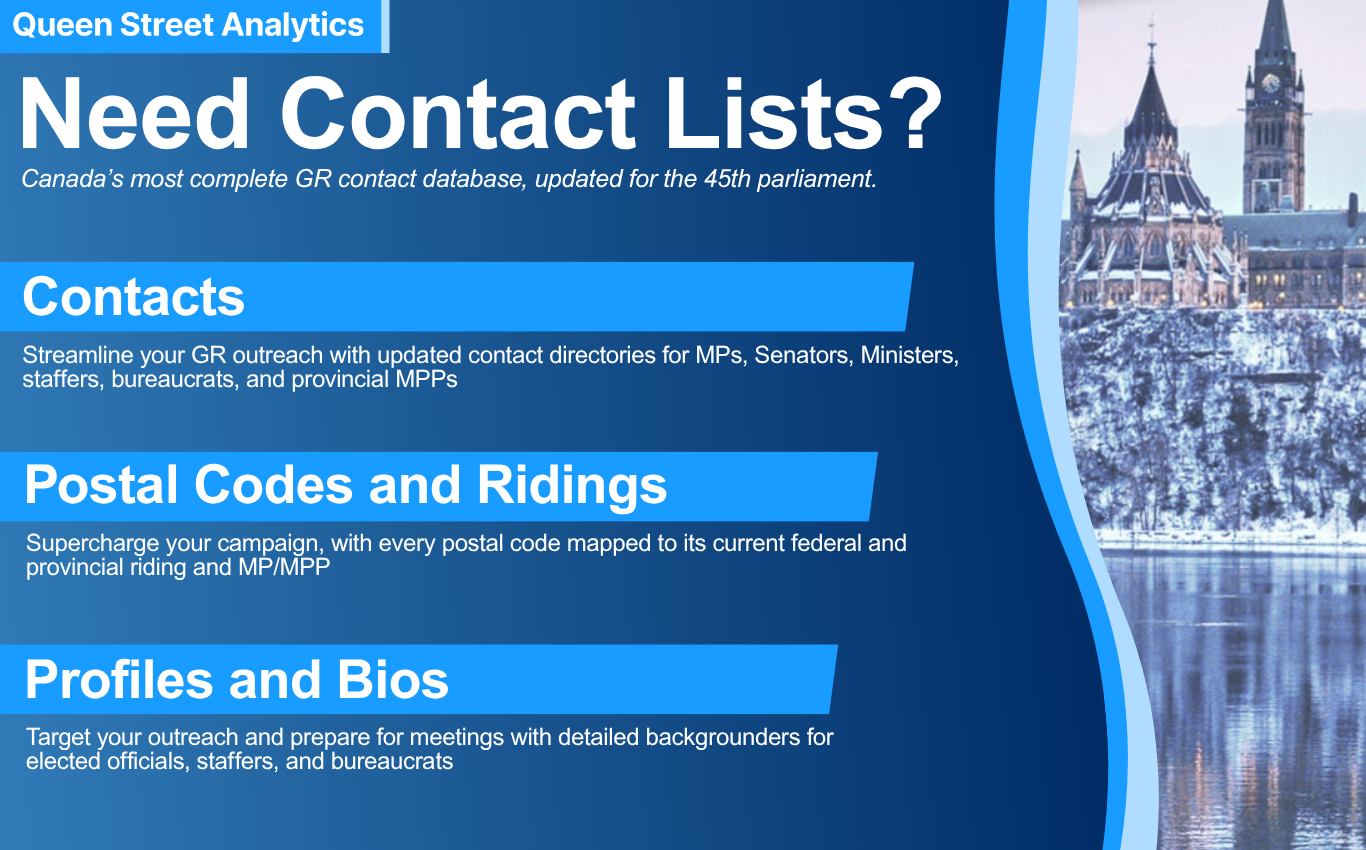QSA's Week in Aviation (#22, 2025)
Canada tables One Canadian Economy Bill to expedite national infrastructure, internal trade; CSA and ESA reaffirm partnership; StatsCan: airport passenger volumes up; FAA issues new ADs for Boeing and Textron; White House signs executive orders on supersonic flight and drone policy.

Good morning! This is Queen Street Analytics' weekly roundup of regulatory developments, legislative discussions, political announcements and other government-related news for the airline and airports industry, as well as pilots and other aviation-professionals. Every Monday, we break down the most important updates in this space in under five minutes.
Looking to elevate and streamline your approach to government relations with more data-driven solutions? Queen Street Analytics is here to help you achieve your goals faster, smarter, and more effectively. Let's start the conversation. Reach out at contact@queenstreetanalytics.com to learn how we can support your success.
Start Date: 2025-06-01
End Date: 2025-06-07
📋 In This Week's Newsletter
• 🇨🇦 Canadian Federal Government News
• 🇺🇸 US GR News
• 📱 Public Officials' Social Media
• 📚 What We're Reading This Week
Canadian Federal GR News
One Canadian Economy Bill Introduced to Accelerate National Projects and Internal Trade
On June 6, the Government of Canada introduced the One Canadian Economy Bill, aiming to enact the Free Trade and Labour Mobility in Canada Act and the Building Canada Act. The bill seeks to reduce internal trade barriers, particularly in sectors such as airports, railways, and ports, and expedite the approval of large-scale infrastructure projects deemed to be in the national interest. A new process would shift federal reviews from deciding 'whether' to proceed with such projects to determining 'how' to advance them efficiently. Once a project is designated as nationally significant, federal approvals would be consolidated through a single conditions document issued by a designated minister, replacing the current system of multiple regulatory decisions. The government has committed to removing further federal exceptions in the Canadian Free Trade Agreement by July 2025.
Sources: Announcements: www.canada.ca

Canada Reaffirms Space Collaboration with European Space Agency
On June 6, Sherry Romanado, Parliamentary Secretary to the Minister of National Defence, and Canadian Space Agency (CSA) President Lisa Campbell hosted Dr. Josef Aschbacher, Director General of the European Space Agency (ESA), at the John H. Chapman Space Centre in Longueuil, Quebec. The two agencies signed a joint statement marking a key milestone in the mid-term review of the Canada-ESA Cooperation Agreement, which has facilitated Canadian access to the European space market for nearly five decades. Canadian companies benefit from ESA contracts with a reported return of three dollars for every dollar awarded.
Sources: Announcements: www.canada.ca
Canadian Space Agency Remembers Marc Garneau
The Canadian Space Agency announced the passing of Marc Garneau, the first Canadian in space, at age 76. Garneau was selected as one of the original six Canadian astronauts in 1983 and flew three shuttle missions. He later served as President of the CSA and as a federal cabinet minister, including terms as Minister of Foreign Affairs and Minister of Transport. Garneau received numerous awards, including the Order of Canada and the NASA Exceptional Service Medal.
Sources: Announcements: www.canada.ca
Minister McGuinty Attends NATO and Ukraine Defense Meetings, Announces Canadian Support for Ukrainian Aviation
Minister of National Defence David J. McGuinty concluded his first official visit to Brussels for the 28th Ukraine Defense Contact Group and a meeting of NATO Defence Ministers. During the meetings, Canada committed over $35 million in additional military aid to Ukraine. Canada also updated partners on advanced pilot training for Ukrainian pilots currently underway domestically. As part of the Air Force Capability Coalition, Canada has invested $389 million over five years in F-16 pilot training and airfield support. Canada also signed on to the NATO Flight Training Europe initiative, which will allow the RCAF to utilize and contribute to allied aircrew training capacity. The visit included bilateral discussions with European ministers and NATO leadership, with a stated focus on allied deterrence and air domain cooperation.
Sources: Announcements: www.canada.ca
CSA and ESA Signal Strategic Space Sector Collaboration
The Canadian Space Agency issued a media advisory on a strengthened partnership with the European Space Agency, referencing ongoing strategic cooperation in space technologies, exploration, and science. No further details were provided in the announcement.
Sources: Announcements: www.canada.ca
StatsCan: Passenger Security Screening at Major Canadian Airports Up 3.6% Year-over-Year
Statistics Canada reported that 4.5 million passengers passed through security screening checkpoints at Canada’s eight largest airports in April 2025. This represents a 3.6% increase from April 2024 and is 1.9% higher than the pre-pandemic level recorded in April 2019.
Sources: Open Government Data Set: www.statcan.gc.ca
StatsCan Releases Weekly Aircraft Movement Data for Late May
Weekly data on aircraft itinerant movements for the period May 17 to May 23, 2025, are now available from Statistics Canada. The dataset provides operational metrics for industry stakeholders.
Sources: Open Government Data Set: www.statcan.gc.ca
US Government Updates
White House Executive Order Targets Supersonic Flight Regulation Reform
On June 6, President Donald J. Trump signed an executive order to promote supersonic aviation in the United States. The order directs the Federal Aviation Administration (FAA) to repeal the prohibition on overland supersonic flight, establish interim noise-based certification standards, and remove regulatory barriers to high-speed flight. Agencies are instructed to coordinate supersonic R&D and pursue international harmonization of regulations. The administration has cited contracts between U.S. aerospace companies and major airlines as evidence of market demand for supersonic commercial service.
Sources: White House Announcements: www.whitehouse.gov
White House Moves to Strengthen Airspace Sovereignty and UAS Restrictions
President Trump signed an executive order on June 6 establishing a Federal Task Force to address threats from unmanned aircraft systems (UAS). The FAA is directed to restrict drone flights over critical infrastructure and provide free public access to airspace restriction data for geofencing. Federal agencies are authorized to detect, track, and identify drones, with grants made available to law enforcement for similar technologies. The order also calls for risk-based designation of protected sites and the creation of a National Training Center for Counter-UAS, with an eye to securing upcoming international events.
Sources: White House Announcements: www.whitehouse.gov
White House Executive Order Accelerates Drone and eVTOL Integration
A separate executive order signed June 6 directs the FAA to advance routine Beyond Visual Line of Sight (BVLOS) drone operations, fast-track waiver reviews using artificial intelligence, and launch a pilot program for electric vertical takeoff and landing (eVTOL) aircraft. The order prioritizes U.S.-manufactured drones in procurement and export, calls for expansion of federal financing tools, and instructs the Department of Defense to streamline airspace access for UAS training. The order is designed to modernize regulations and strengthen the domestic drone industrial base.
Sources: White House Announcements: www.whitehouse.gov
FAA Issues Airworthiness Directive for Boeing 757 Series
On June 3, the FAA adopted a new airworthiness directive (AD) for certain Boeing 757-200, -200CB, and -300 series aircraft following reports of cracking at body station 1640. The AD requires operators to inspect for approved repairs, conduct repetitive eddy current inspections, and implement corrective measures as needed. The directive is effective July 8, 2025, and applies to 481 U.S.-registered aircraft. Operators must comply with the procedures outlined in Boeing Alert Requirements Bulletin 757-53A0123 RB and related service bulletins.
Sources: U.S. Federal Announcements: www.federalregister.gov
FAA Issues Airworthiness Directive for Textron Model 560 and 560XL
The FAA released a new AD effective July 11, 2025, for Textron Aviation Model 560 and 560XL aircraft, addressing reports of mis-wired fire extinguishing bottles. The AD requires functional testing, inspection of bottle cartridge wire numbers and ID sleeves, and program revisions to include new airworthiness limitations. The directive affects 1,245 U.S.-registered aircraft, with an estimated compliance cost of $211,650 for initial inspections and additional costs for corrective actions. Operators must adhere to the procedures set out in Textron Aviation Citation Service Letters SL560-26-02 and SL560XL-26-02.
Sources: U.S. Federal Announcements: www.federalregister.gov
Public Officials' Social Media
On June 6, MP Tim Hodgson posted about the Free Trade and Labour Mobility in Canada Act, noting its measures to harmonize standards and coordinate federal and provincial rules for goods and workers.
Sources: Social Media: x.com
MP Parm Bains reported on June 5 that he met with the Vancouver Airport Authority to discuss cargo business expansion and federal support for YVR as a key transit hub.
Sources: Social Media: x.com
What We're Reading This Week
- ‘Gold standard for aviation training’: Western University partners with MFC: Western University launched an aviation training partnership with Moncton Flight College.
- Parsons Selected for the Austin-Bergstrom International Airport Program Management Contract: Parsons was awarded the program management contract at Austin-Bergstrom International Airport.
- Number of people from Canada flying to the U.S. plunges in April: StatCan report: StatCan data indicate a significant drop in Canadians flying to the U.S. in April amid trade tensions.
- Airlines association cuts industry’s profit outlook due to trade barriers, delivery delays: An airlines association revised its profit outlook downward, linking the change to trade barriers and aircraft delivery delays.
- Air Canada reminds shareholders of upcoming expiry of substantial issuer bid: A repeat notice for Air Canada shareholders regarding the issuer bid expiry.
- Airlines association cuts industry’s profit outlook due to trade barriers, delivery delays: The industry outlook is revised amid trade and supply chain disruptions.

